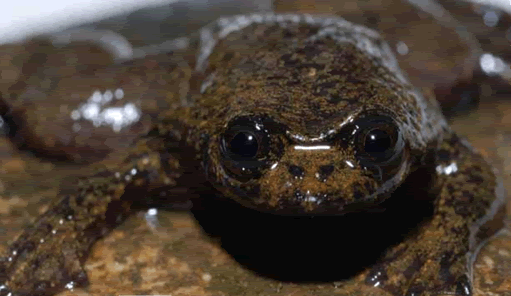
Photo courtesy of David Bickford, National University of Singapore.
This morning the news is full of the announcement about the discovery of a lunglesss frog, Barbourula kalimantanensis affectionately nicknamed, “Barbie.”
Found in Borneo, news sources report that it is the first such frog found–however scientists first saw and collected one about 30 years ago. They did not dissect and study the animal and so did not report on the unique respiratory feature.
So how does it breathe?
Through the skin–it respirates the same way that salamanders and a limbless amphibian species of caecilian (Atretochoana eiselti) do.
David P. Bickford, one of the scientists credited with the discovery, is an evolutionary biologist with broad interests in evolutionary ecology and conservation.
Bickford has given a few talks about his research at the Raffles Museum of Biodiversity Research. He also leads the Evolutionary Ecology and Conservation Lab.
The amphibians are slightly more than two inches long, slippery and can swim surprisingly fast for short bursts. Moreover, they are very difficult to find. “We had a team of 11 people looking for these frogs and it took us almost two weeks before we found any,” Dr Bickford recalled.
Snorkelling in the rivers where the frogs live, the researchers were forced to stop after 45 minutes as the water was too cold.
“Nobody knew about the lunglessness before we accidentally discovered it doing routine dissections,” said Dr Bickford in an interview with National Geographic News.
Their findings will also be featured in Current Biology (May 2008).
You can read more from the initial release at the National University of Singapore (NUS) website.
The frog lives in cold water which has higher oxygen content than warm water and it is believed that the animal has a low metabolic rate–which means it needs less oxygen. It is also is flat (compared to other frogs) which increases the surface area of the skin and assists in a more efficient intake of oxygen.
The absence of lungs also means less buoyancy for the frog and would help prevent it from being easily swept away by the fast-flowing waters where it lives.
It takes time for discoveries to hit the mainstream and the frog was actually found in August of 2007. Laboratory studies were done and the detailed findings of David Bickford, Djoko Iskandar, and Anggraini Barlian will be published next month.
If you want an inside glimpse visit The Biodiversity Crew @ NUS blog for the story and “poster boy” photos of Bickford and a few others on site and in the lab.
You can read more now about “Barbie” the frog here or the lungless frog here.

